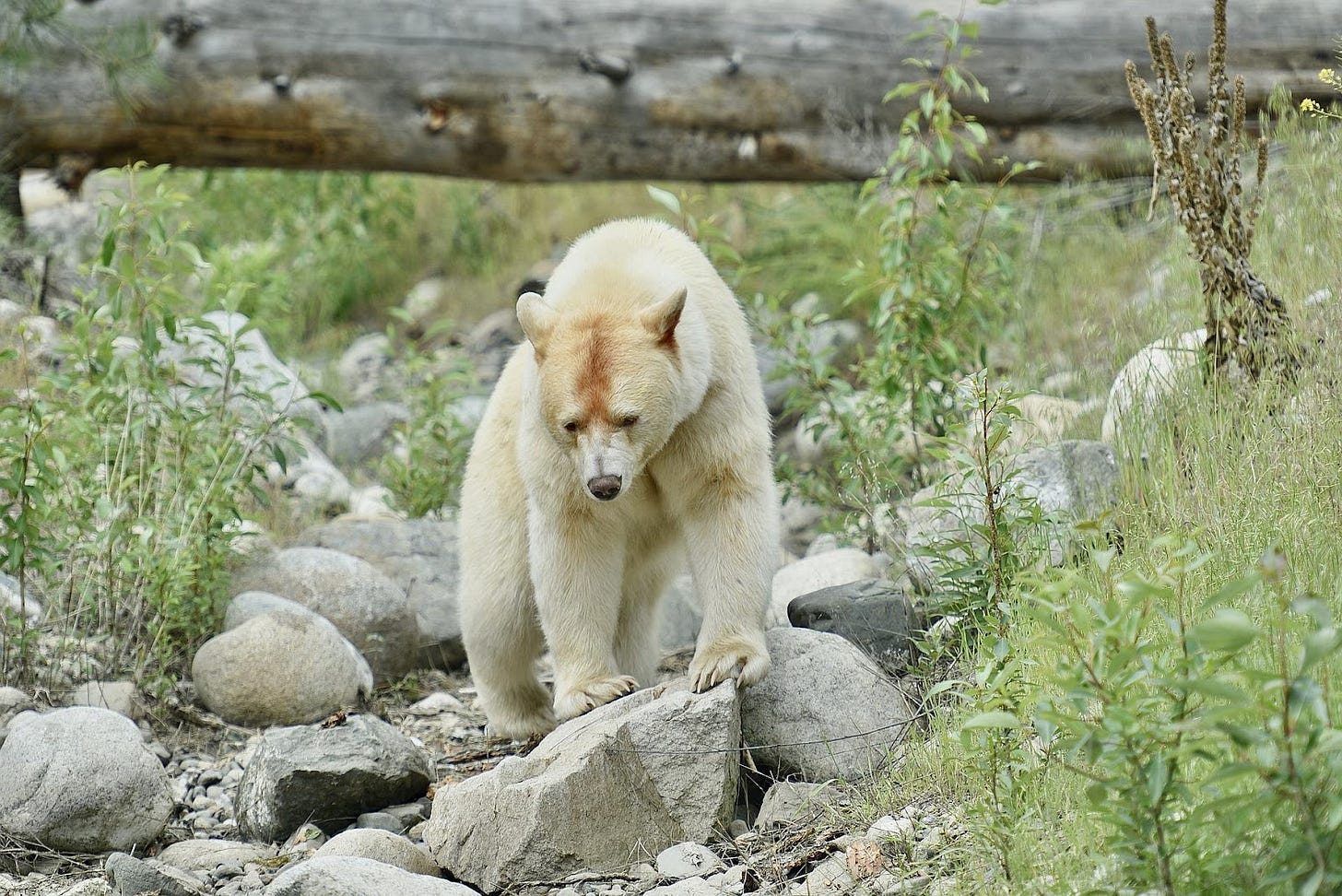#11 The Big Business of Black Bears & Paper-Fueled Planes

Morning Jo(ke)
"We should be more conservative with gas. SUVs ... probably not necessary. Hummers?! Do you really need an armored vehicle to get groceries or pick your kids up from soccer practice? That is the same vehicle the military uses for combat in Afghanistan and you're getting Egg Beaters in it. Sure, you should be 'allowed' to drive a Hummer, but I think the new rules should be the rest of us get to shoot at you. If you want to pretend you're in the Army, we'll make it more realistic."
- Forrest Shaw
Greening Pastures
Nested in Klemtu on Swindle Island in British Columbia, Canada is the eco-tourism hotspot known as Spirit Bear Lodge. The destination is owned and operated by two native tribes, the Kitasoo and the Xai’xais who share a community in Klemtu.
For many years, the two tribes’ elders wouldn’t even speak of the spirit bear (AKA the Kermode bear) to outsiders out of fear it would be hunted into extinction. For, the spirit bear, a subspecies of black bear whose coat is actually white like a polar bear’s, is very important to the tribes’ culture.


However, since opening the Spirit Bear Lodge two decades ago, just the opposite has happened. The lodge has attracted researchers of the spirit bear, which have strengthened the protection of the Nation’s territory and established a culture of stewardship.
The lodge’s namesake is also their primary tourist attraction. The staff offer guided tours where visitors have a chance to witness the rare animal from a both personally and ecologically safe distance.
Rather than deposited into a CEO’s pocketbook, the revenue generated from this business is reinvested into the land. Now, the lodge has three separate programs: the Spirit Lodge bear-viewing business; the Spirit Bear Research Foundation, which researches and informs management decisions; and the Guardian Watchmen Program, which protects and patrols the territory. All three of these work in tandem to form a web of stewardship.
The lodge also invests in their community. Ten percent of the local population is employed on some level at the lodge. They also provide money for youth development, stewardship, and language revitalization programs.
Previously, the area relied on an extraction economy for fish and forest, but it has evolved into a thriving, regenerative business thanks to the lodge. Now, fifty percent of the territory is protected from logging, mining, and resource extraction with exceptions for community members to use it for food gathering, traditional uses, and ecotourism. While some might view any use of this land as negative, this is an essential part of conservation for retaining traditional rights.
The Spirit Bear Lodge is also reinvesting in the world. For other indigenous communities looking to establish similar business models, they’ve identified ten factors as reasons for their success that they freely share with the hopes that other areas will be able to recreate it and protect their land as well.
Budding Hope
In September of 2021, the U.S. government launched the Sustainable Aviation Fuel Grand Challenge to supply 100% of aviation fuel demands with sustainable fuels by 2050 and reduce their greenhouse gas emissions by 50% based on conventional jet fuels averages. The collaboration with the Department of Energy, Department of Transportation, and Department of Agriculture aims to reduce the cost, increase the sustainability, and expand the production of sustainable aviation fuels.
A sustainable aviation fuel is a biofuel used to power aircraft that has similar properties to conventional jet fuel but with a smaller carbon footprint.
Now, researchers have created a sustainable aviation fuel that could compete with conventional petroleum-based fuels.
Check out another sustainable aviation fuel that uses mustard oil here:
Lignin, which makes up plant tissue, is an abundant waste product from both the paper and ethanol industry. As of 2019, worldwide lignin production was estimated to be 50 million tons (~45 million tonnes) per year, but 98-99% of that is put back into the paper industry by burning it for power. This new avenue of utilization, however, could turn this waste into a high-value product.
A new method from Washington State University uses lignin to make a high performing jet fuel. The researchers blended a lignin-based jet fuel with conventional jet fuel, and its performance was shockingly high. Currently, conventional jet fuels use “aromatic compounds” to seal the metal joints in engines, but this lignin-based fuel blend was able to seal the metal joints just as well.
These aromatic compounds are also a large reason as to why aviation fuels have high emissions. Since the lignin-based fuels don’t have these compounds, this sustainable aviation fuel would greatly reduce the greenhouse gas emissions resulting from burning jet fuel (3.16 kg CO2/ kg jet fuel burned).
With such high performance and reduction on greenhouse gas emissions, this lignin-based jet fuel could become a huge piece in reaching the goals of Biden’s Sustainable Aviation Fuel Grand Challenge.
Feeling Inspired?
Did you know that the average showerhead uses 2.5 gallons of water per minute? Well, now you do! And that’s a lot of water. Luckily, there are low-flow showerheads that use a fraction of that.
I know what you’re thinking, “well I’m not going to be as wet then!” Not true, low-flow showerheads can have just as strong a spray and even come in the fancy little patterns that you know and love. Plus, if you switch to one of these wonderful devices, you’ll not only be saving water but also money!
When picking one out in the U.S., make sure to look for the WaterSense label so you know it meets the EPA’s standards:
Branch Out
The hit interview show Ziwe is spectacular, but this interview with Ilana Glazer is particularly wonderful. They talk about ecological responsibility, climate change, and Ilana even apologizes to a literal child!




